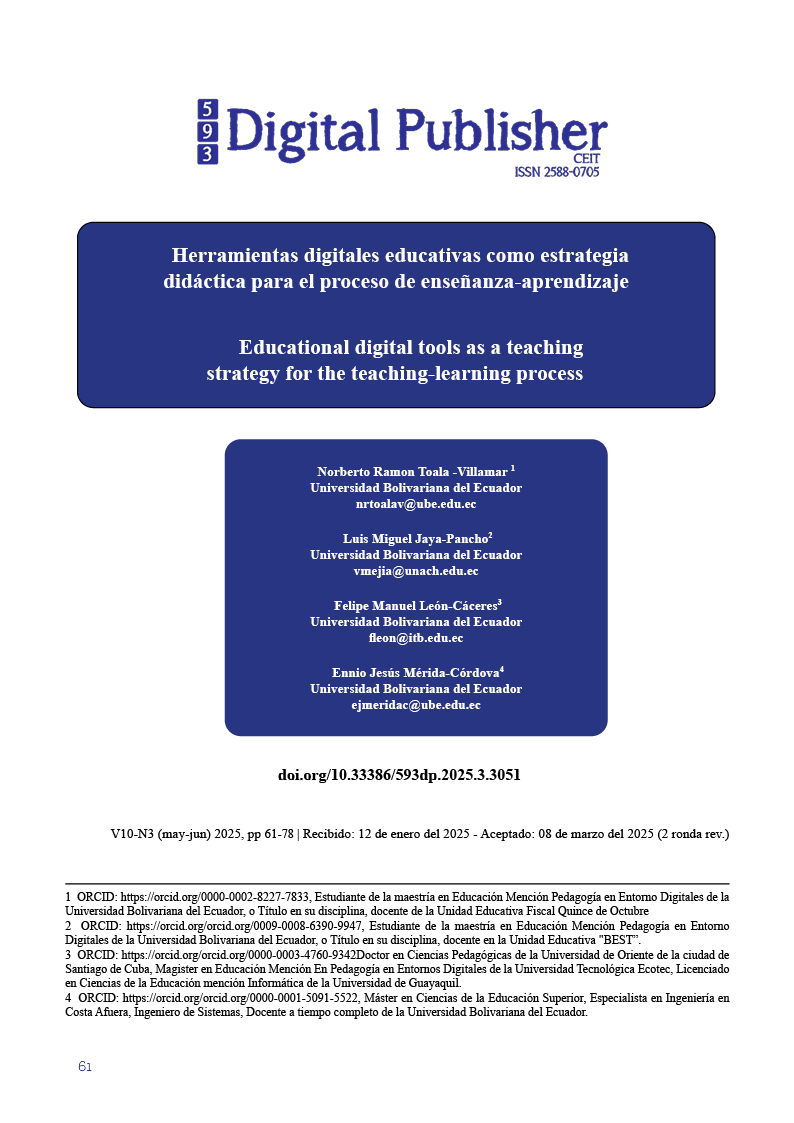Educational digital tools as a teaching strategy for the teaching-learning process
Main Article Content
Abstract
Educational technological applications have become an essential resource for the teaching-learning process. The objective is to develop a teaching strategy based on the use of digital tools for better academic performance in first-year high school students, including project management applications, presentation and scientific research software, and interactive resources that encourage active participation and autonomous learning. It was observed that regular use of applications improves the organization, collaboration and creativity of students. This research is based on a mixed methodology, combining qualitative and quantitative approaches. A quantitative approach was used through surveys to measure the impact of digital tools, therefore, we will work with direct observation, interview and survey techniques, aimed at first-year high school students, allowing the consolidation of achievable and valid measurable results. 90% of the results show that the integration of digital tools in the educational process allows the individual academic performance of each student to be improved and promotes more dynamic and participatory learning. Furthermore, the use of these technologies contributes to developing digital skills. Educational digital applications present an effective strategy to improve the academic performance of first-year high school students, offering a more interactive teaching-learning approach, naturally offering the creation of an inclusive digital learning environment, the implementation of active techniques that encourage critical thinking and problem solving
Downloads
Article Details

This work is licensed under a Creative Commons Attribution-NonCommercial-ShareAlike 4.0 International License.
1. Derechos de autor
Las obras que se publican en 593 Digital Publisher CEIT están sujetas a los siguientes términos:
1.1. 593 Digital Publisher CEIT, conserva los derechos patrimoniales (copyright) de las obras publicadas, favorece y permite la reutilización de las mismas bajo la licencia Licencia Creative Commons 4.0 de Reconocimiento-NoComercial-CompartirIgual 4.0, por lo cual se pueden copiar, usar, difundir, transmitir y exponer públicamente, siempre que:
1.1.a. Se cite la autoría y fuente original de su publicación (revista, editorial, URL).
1.1.b. No se usen para fines comerciales u onerosos.
1.1.c. Se mencione la existencia y especificaciones de esta licencia de uso.
References
Arcentales Fajardo, M., García Herrera, D., Cárdenas Cordero, N., y Erazo Álvarez, J. (15 de 11 de 2020). Dialnet. Canva como estrategia didáctica en la enseñanza de Lengua y Literatura: file:///C:/Users/celno/Downloads/Dialnet-CanvaComoEstrategiaDidacticaEnLaEnsenanzaDeLenguaY-8318340.pdf
Arimetrics. (2022). Arimetrics. Qué es Google Drive: https://www.arimetrics.com/glosario-digital/google-drive
BARRIGA ARCEO, F. D., y HERNÁNDEZ ROJAS, G. (2004). ESTRATEGIAS DOCENTES PARA UN APRENDIZAJE SIGNIFICATIVO. McGRAW-HILL INTERAMERICANA. https://doi.org/https://dfa.edomex.gob.mx/sites/dfa.edomex.gob.mx/files/files/2_%20estrategias-docentes-para-un-aprendizaje-significativo.pdf
Barrios R., I., y Casadei, L. (2024 de 03 de 2014). PROMOVIENDO EL USO DE GOOGLE DRIVE COMO HERRAMIENTA DE TRABAJO COLABORATIVO EN LA NUBE PARA ESTUDIANTES DE INGENIERíA. Revista de Tecnología de Información y Comunicación en Educació: http://servicio.bc.uc.edu.ve/educacion/eduweb/v8n1/art03.pdf
BIU, Universidad Americana. (12 de 05 de 2023). BIU, universidad americana. Broward International University: https://www.biu.us/blog/articulos/chatgpt-que-es-y-como-esta-impactando-la-educacion
Brito Salazar, C., Pardo Gómez, M. E., y Soler Rodríguez, R. (16 de 07 de 2022). Revista Electrónica Formación y Calidad Educativa (REFCalE) ECOSISTEMA DIGITAL DE EDUCACIÓN 4.0. ECOSISTEMA DIGITAL DE EDUCACIÓN 4.0. UNA PROPUESTA DE NNOVACIÓN PARA LA FORMACIÓN UNIVERSITARIA: file:///C:/Users/celno/Downloads/3605-Texto%20del%20art%C3%ADculo-8483-1-10-20220812.pdf
Cabanillas García, J. L., Luengo González, R., y Torres Carvalho, J. L. (15 de Julio de 2019). La búsqueda de información, la selección y creación de contenidos y la comunicación docente. https://www.redalyc.org/journal/3314/331462375013/html/
CAE INNOVATIVE LEARNING SOLUTIONS. (12 de 03 de 2024). CAE INNOVATIVE LEARNING SOLUTIONS. Tecnología e-learning y soluciones educativas online: https://www.cae.net/es/beneficios-gamificacion-aprendizaje/
Canva. (s.f.). Canva. El poder del diseñoa tu alcance: https://www.canva.com/es_es/about/
Cifuentes Pulido, S. P., y Ramos Duran, J. H. (19 de 11 de 2020). Duolingo Como Estrategia Pedagógica Para Fortalecer el Aprendizaje de Inglés . https://repositorio.udes.edu.co/entities/publication/3b78c9c7-ac97-41e9-962f-ed16b83cf35d
Cruz Fagundes, L. D., Bernal, O. M., Martínez Alvarado, H., Padilha, M., Piscitelli, A., Segura, M., y Sunkel, G. (s.f.). Los desafíos de las TIC para el cambio educativo. Metas Educativas 2021: https://www.oei.es/uploads/files/microsites/28/140/lastic2.pdf
De la Torre, S. (21 de 09 de 2023). iseazy. Herramientas Digitales Educativas: Transformando la forma de aprender: https://www.iseazy.com/es/blog/herramientas-digitales-educativas/
Duolingo. (05 de 2022). Duolingo. Ayuda: https://support.duolingo.com/hc/es/articles/204829090--Qu%C3%A9-es-Duolingo
Espinal Montalván, M. E., y Sanz Martínez, O. (29 de 06 de 2023). MQRInvestigar Revista Científica. Estrategia didáctica para fortalecer el aprendizaje autónomo de los estudiantes de segundo de Bachillerato.: https://www.investigarmqr.com/ojs/index.php/mqr/article/view/441
Forero, T. (19 de 03 de 2020). Rockcontent Blog. Principales impactos de la inteligencia artificial (IA) en la educación y sus posibilidades futuras: https://rockcontent.com/es/blog/inteligencia-artificial-en-la-educacion/
Genial.ly. (s.f.). Genial.ly. ¿Qué es Genial.ly?: https://www.cyldigital.es/sites/default/files/selflearning/scorm/cdb9566c/2_qu_es_genially.html
Kadenlive. (11 de 09 de 2020). Kadenlive. Caracteristicas: https://kdenlive.org/es/caracteristicas/#pll_switcher
Lopez, M. (7 de 02 de 2024). IMMUNE Tecnology Institute. Realidad aumentada en educación: transformando el aprendizaje: https://immune.institute/blog/realidad-aumentada-en-educacion-aplicaciones-practicas/
Ministerio de Educación del Ecuador. (2022). Crea Innovación Educativa. Memorias de las mesas de diálogo para la construcción del Laboratorio de Innovación Educativa del Ecuador: https://recursos.educacion.gob.ec/innovacion-educativa/
Ortega, C. (2020). Question Pro. Inicio Investigación de mercado: https://www.questionpro.com/blog/es/metodologia-de-la-investigacion/
Pérez Barrera, H. M. (7 de 2024). Implementación de Genially como estrategia en el proceso de enseñanza-aprendizaje de Ciencias Naturales . https://mendive.upr.edu.cu/index.php/MendiveUPR/article/view/3722
Rivera Lombeyda, F. X., Duarte Morante, P. L., Campoverde Nevarez, L. H., y Ortiz Torres, M. G. (15 de 08 de 2024). mpacto del uso de las IA como estrategias metodológicas en la educación superior. file:///C:/Users/celno/Downloads/7823-41017-1-PB.pdf
Romero, I. (14 de 12 de 2022). Metricool Blog. Qué es YouTube y cómo usarlo: https://metricool.com/es/que-es-youtube/
Sandoval Poveda, A. M., y Tabash Pérez, F. (10 de 2021). Scielo Revista Innovaciones Educativas. Realidad virtual como apoyo innovador en la educación a distancia: https://www.scielo.sa.cr/scielo.php?script=sci_arttext&pid=S2215-41322021000300120
Sousa Ferreira, R., Campanari Xavier, R. A., y Rodrigues Ancioto, A. S. (04 de 12 de 2020). La realidad virtual como herramienta para la educación básica y profesional. https://www.redalyc.org/journal/4762/476268269011/html/
Torres Cardona, L. (21 de 11 de 2023). Instituto Superior de Estudios Psicológicos. El rendimiento académico y su relación con los problemas emocionales y conductuales en el aula: https://www.isep.es/actualidad/rendimiento-academico-problemas-emocionales-conductuales-aula/
Veintimilla Guerrero, M. Á., Veintimilla Guerrero, B. A., y Nivela Cornejo, M. A. (7 de 2023). Revista Academica cientifica VICTEC. Incidencia del uso de herramientas digitales como estrategia didáctica en el nivel de bachillerato general unificado del sistema ecuatoriano: http://portal.amelica.org/ameli/journal/572/5724522003/html/
Vera Balderas, S., y Moreno Tapia, J. (28 de 05 de 2021). Experiencias de aprendizaje en YouTube, un análisis durante la pandemia de COVID-19. https://www.redalyc.org/journal/5216/521665144013/html/





